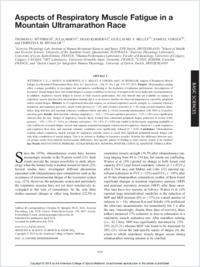Aspects of respiratory muscle fatigue in a mountain ultramarathon race.
- Wüthrich TU 1Exercise Physiology Lab, Institute of Human Movement Sciences and Sport, ETH Zurich, SWITZERLAND; 2School of Health and Exercise Science, University of the Sunshine Coast, Queensland, AUSTRALIA; 3Exercise Physiology Laboratory, University of Lyon, Saint-Étienne, FRANCE; 4Human Performance Laboratory, Faculty of Kinesiology, University of Calgary, Calgary, CANADA; 5HP2 Laboratory, University Grenoble Alpes, Grenoble, FRANCE; 6U1042, INSERM, Grenoble, FRANCE; and 7Zurich Center for Integrative Human Physiology, University of Zurich, Zurich, SWITZERLAND.
- Marty J
- Kerherve H
- Millet GY
- Verges S
- Spengler CM
- 2014-07-18
Published in:
- Medicine and science in sports and exercise. - 2015
English
PURPOSE
Ultramarathon running offers a unique possibility to investigate the mechanisms contributing to the limitation of endurance performance. Investigations of locomotor muscle fatigue show that central fatigue is a major contributor to the loss of strength in the lower limbs after an ultramarathon. In addition, respiratory muscle fatigue is known to limit exercise performance, but only limited data are available on changes in respiratory muscle function after ultramarathon running and it is not known whether the observed impairment is caused by peripheral and/or central fatigue.
METHODS
In 22 experienced ultra-trail runners, we assessed respiratory muscle strength, i.e., maximal voluntary inspiratory and expiratory pressures, mouth twitch pressure (n = 16), and voluntary activation (n = 16) using cervical magnetic stimulation, lung function, and maximal voluntary ventilation before and after a 110-km mountain ultramarathon with 5862 m of positive elevation gain.
RESULTS
Both maximal voluntary inspiratory (-16% ± 13%) and expiratory pressures (-21% ± 14%) were significantly reduced after the race. Fatigue of inspiratory muscles likely resulted from substantial peripheral fatigue (reduction in mouth twitch pressure, -19% ± 15%; P < 0.01), as voluntary activation (-3% ± 6%, P = 0.09) only tended to be decreased, suggesting negligible or only mild levels of central fatigue. Forced vital capacity remained unchanged, whereas forced expiratory volume in 1 s, peak inspiratory and expiratory flow rates, and maximal voluntary ventilation were significantly reduced (P < 0.05).
CONCLUSIONS
Ultraendurance running reduces respiratory muscle strength for inspiratory muscles shown to result from significant peripheral muscle fatigue with only little contribution of central fatigue. This is in contrast to findings in locomotor muscles. Whether this difference between muscle groups results from inherent neuromuscular differences, their specific pattern of loading or other reasons remain to be clarified.
Ultramarathon running offers a unique possibility to investigate the mechanisms contributing to the limitation of endurance performance. Investigations of locomotor muscle fatigue show that central fatigue is a major contributor to the loss of strength in the lower limbs after an ultramarathon. In addition, respiratory muscle fatigue is known to limit exercise performance, but only limited data are available on changes in respiratory muscle function after ultramarathon running and it is not known whether the observed impairment is caused by peripheral and/or central fatigue.
METHODS
In 22 experienced ultra-trail runners, we assessed respiratory muscle strength, i.e., maximal voluntary inspiratory and expiratory pressures, mouth twitch pressure (n = 16), and voluntary activation (n = 16) using cervical magnetic stimulation, lung function, and maximal voluntary ventilation before and after a 110-km mountain ultramarathon with 5862 m of positive elevation gain.
RESULTS
Both maximal voluntary inspiratory (-16% ± 13%) and expiratory pressures (-21% ± 14%) were significantly reduced after the race. Fatigue of inspiratory muscles likely resulted from substantial peripheral fatigue (reduction in mouth twitch pressure, -19% ± 15%; P < 0.01), as voluntary activation (-3% ± 6%, P = 0.09) only tended to be decreased, suggesting negligible or only mild levels of central fatigue. Forced vital capacity remained unchanged, whereas forced expiratory volume in 1 s, peak inspiratory and expiratory flow rates, and maximal voluntary ventilation were significantly reduced (P < 0.05).
CONCLUSIONS
Ultraendurance running reduces respiratory muscle strength for inspiratory muscles shown to result from significant peripheral muscle fatigue with only little contribution of central fatigue. This is in contrast to findings in locomotor muscles. Whether this difference between muscle groups results from inherent neuromuscular differences, their specific pattern of loading or other reasons remain to be clarified.
- Language
-
- English
- Open access status
- green
- Identifiers
-
- DOI 10.1249/MSS.0000000000000449
- PMID 25033264
- Persistent URL
- https://sonar.ch/global/documents/154956
Statistics
Document views: 19
File downloads:
- fulltext.pdf: 0
